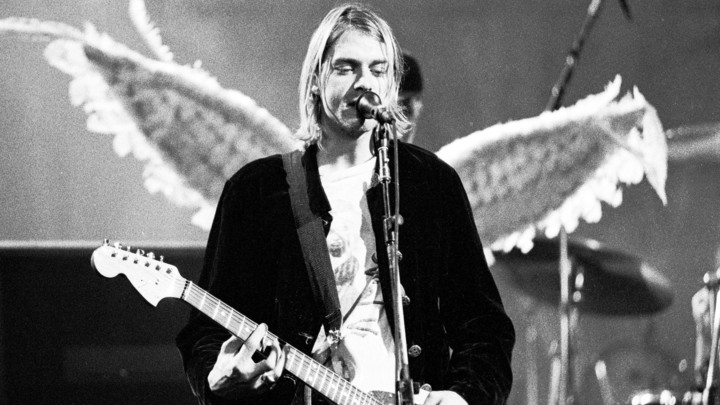Since his death in April 1994, the mythology and myriad iconography of Kurt Cobain has remained ever prevalent in the public sphere. A face on a t-shirt for his generation and many more to come, the Cobain legend has proved and endless well of fascination for rock historians, conspiracy theorists and the common man alike, not least due to the still mysterious circumstances surrounding his last days. With full support of the Cobain estate, Director Brett Morgen thrives to lift the veil on the man’s life, if not his death, in the sprawling, hyperactive and only occasionally exhausting Kurt Cobain: Montage Of Heck. From his troubled Washington upbringing through to the first suicide attempt in March 1994, Morgan’s film provides a strikingly intimate portrait of an endlessly troubled soul.”
Morgen draws upon vaults worth of home movies, diary entries,sketches and audio recordings, compounded with animated segments and sparingly used talking-head interviews with those that knew Cobain as best one possibly could. Opening with Kurt’s infamous entrance via wheelchair at the 1992 Reading festival, Morgen takes this as the apex of Cobain’s domination of pop-culture in the Generation X period, before pulling back to reveal the inner-trauma which has since become canon to the Cobain myth. Kurt’s fractured upbringing grounds the future voice of a generation as a relatable figure, his family’s rejection forming the bedrock of his personal struggles in years to come. Cobain Snr. appears visibly uncomfortable when recounting this period, while mother Wendy is admirably candid. First-hand accounts are provided through the use of endless diary entries from Cobain himself, Morgen often pushing these and animated versions of the avid painter’s often disturbing sketches to the forefront of the narrative. One of the film’s most arresting sequences sees a sudden digression into animation, with Cobain’s audio providing commentary on his intense feelings of depression at this young age.
This unpredictable structure often serves to reflect the fractured mindset of Cobain himself, reaching another level of chaotic beauty with his discovery of music. Even following formation of Nirvana, Morgen retains a keen focus on the man himself, foregoing discussion of the band’s place within the Seattle scene and keenly stressing the empowering quality that creativity had upon Cobain. In these sections, Montage of Heck gleefully captures the reprieve from darkness that Cobain’s writing had upon him, and pushes the film towards a celebratory mid-section composed of footage from early club gigs as Nirvana trudged their way towards international stardom. Inevitably, the notoriety that comes with such territory only served to worsen the newly-crowned voice of a generation’s condition. TV Interviews provide a glimpse of the increasingly withdrawn frontman doing as little as possible to satisfy the demands of what he called ‘Empty-TV’. Yet, as Morgen conveys, none of this was accidental. Journal clippings and interviews alike attest to Cobain’s unshakable ambition, his handwritten itinerary for the iconic ‘Smells Like Teen Spirit’ video betraying a willingness to control public perception of his band as they spiralled into the mainstream. This was paired with a lifelong fear of ridicule, as bandmate Krist Novoselic remarks on an early scathing review, “Kurt hated being humiliated, HATED it”. By honing in on the man at the centre of the hurricane, Montage of Heck highlights the unnatural, unhealthy nature of fame and hero worship, and its effects upon the individual unwilling to receive such praise.
Morgen is careful not to ascribe this as the primary cause for Cobain’s depression and issues with substance abuse. In the greater context conveyed here, Nirvana’s ascension provides the absurd centerpiece of one man’s life, as much a gift to others as it was fertile ground for journalistic vultures, blind to the fragility of their ‘junkie’ subject. Home movies shed light on a period where, in the midst of the Nevermind tour and exhausted by the rigours of his schedule, Cobain decamped to his house with wife Courtney Love for six months of painting and heroin. In interviews, Love is surprisingly candid, not shying from the fact that she acted as an enabler in this case. In the context of what’s to come, the sight of the pockmarked, malnourished Cobain is particularly affecting. His career may have produced one more studio album, the willingly challenging In Utero, as well as the MTV: Unplugged performance that plays us out, but here, we can first glimpse the beginning of the end for Kurt Cobain.
Morgen’s incisive portrait of Cobain proves highly affecting, allowing the audience an insight into a man that few knew as well as they would have liked to. Its a humanistic celebration of artistry as much as it is a look at the fragility of the human condition. At over two hours, it’s occasionally exhausting in its manic energy, yet few wouldargue that it doesn’t provide a beguiling, often touching look at its troubled subject.

